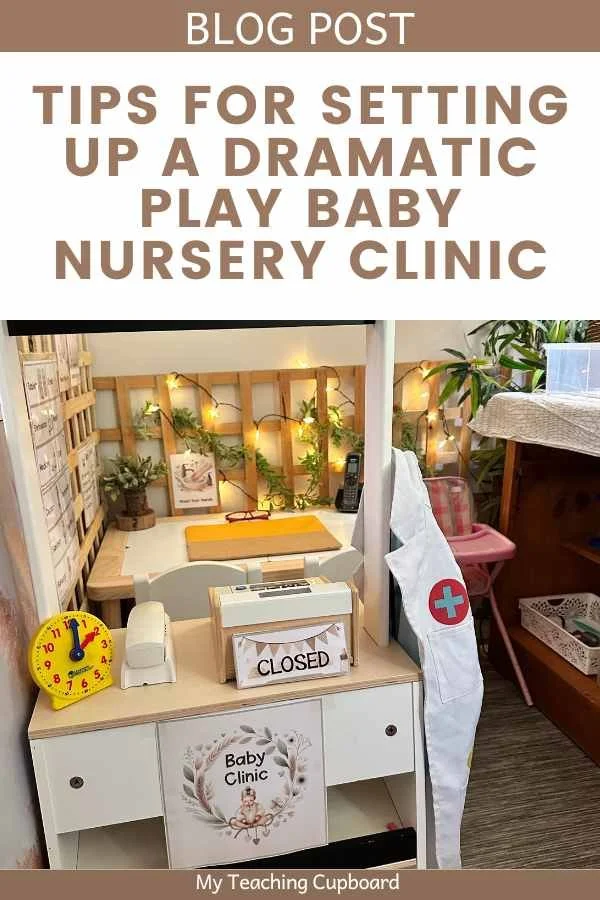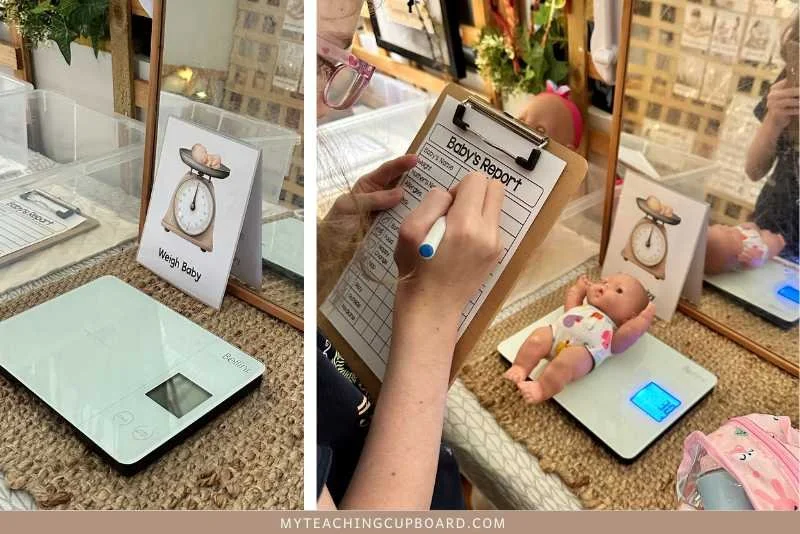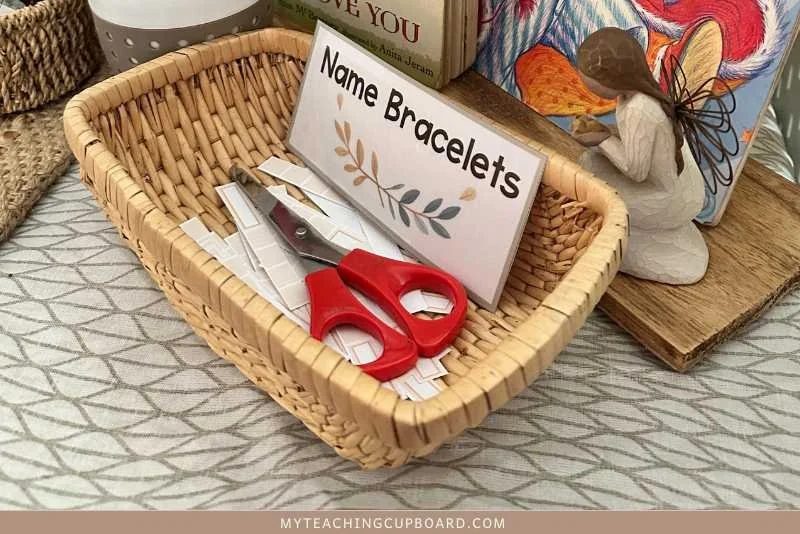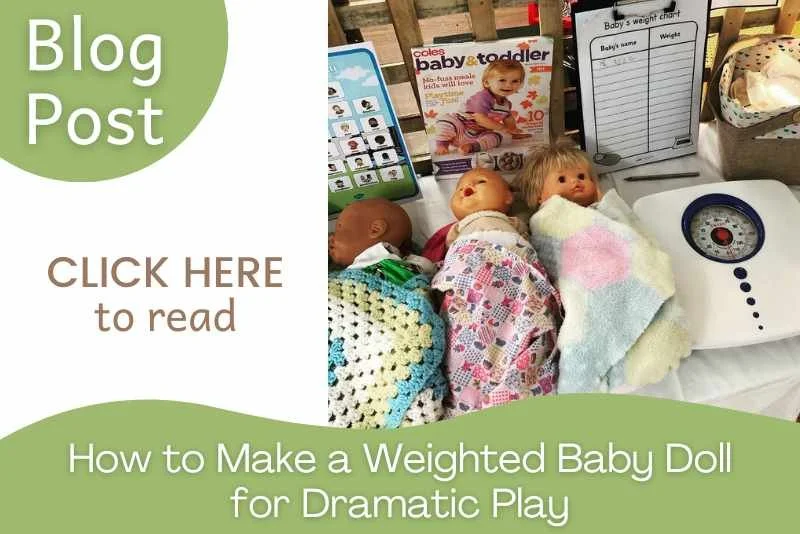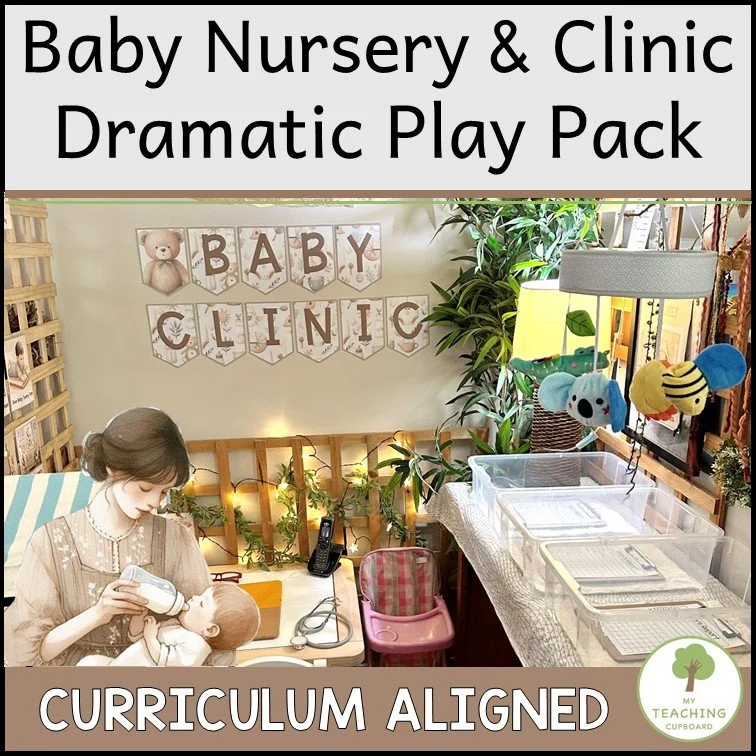How to Set Up a Dramatic Play Baby Nursery in Your Classroom
Looking to set up a dramatic play baby nursery in your classroom? This step-by-step guide for preschool, kindergarten, and early years teachers shares everything you need from materials to curriculum links. Create an engaging play-based space that supports literacy, numeracy, and SEL.
Have you ever wished your dramatic play area felt more purposeful and better aligned with your curriculum goals?
Many early years teachers feel the pressure to meet all those learning outcomes, but still want to give their young children the freedom to play, explore, and imagine because, well... we all know how much little learners thrive in open-ended, hands-on experiences that feel real and meaningful to them.
That’s exactly why my dramatic play baby nursery has been a staple in my classroom for years.
Sure - it’s a pretty cute idea and very popular with the children but it is so much more than that! It is a great way to teach everything from social skills and fine motor skills to math skills, hand-eye coordination, and even literacy through environmental print.
I’ve seen first-hand how children engage deeply with this pretend play area, taking on a specific role, caring for dolls, wrapping them in blankets, measuring them, checking charts, filling out a daily report, and discussing their baby’s day with their friends.
In this blog post, I’ll walk you through easy steps for setting up your very own baby nursery dramatic play center. One that’s not only inviting and imaginative but fully curriculum-aligned.
I’ll also share how we used it in my classroom to explore measurement concepts like comparing baby lengths and using a digital scale to weigh the babies. You'll discover how this play area can become a springboard for authentic, purposeful learning.
And if you're short on time (and let's be honest, who isn't?), I’ll show you how to get started quickly using my ready-to-go Baby Nursery Pretend Play Printables Dramatic Play Pack.
Why Dramatic Play Baby Nursery Setups Are More Than Just “Play”
"Play is the work of the child." — Maria Montessori
Some people see a group of children playing in a dramatic play area and assume it’s all just fun and games. But for those of us who teach in the early years, we know it’s so much more than that.
When young learners step into a baby nursery dramatic play center, they’re engaging in symbolic play - using one object to represent another. This type of play is a vital part of brain development, helping children form neural connections related to memory, language, and imagination. Symbolic play lays the groundwork for literacy, storytelling, and abstract thinking later on.
The Walker Learning Approach reinforces the power of dramatic play. As stated in their book Play Matters: “Children need many opportunities for dramatic play. This is a major way in which oral language and a range of other literacy and numeracy skills are developed, as well as problem solving, decision making, persistence, creative and lateral thinking.”
This is particularly evident in a dramatic play baby nursery where young children take on the specific roles of doctors, nurses, parents, or caregivers. Through these roles, they practice language development, build executive functioning skills like planning and regulating their behaviour, and learn to empathise with others by comforting a crying doll, solving a problem with a friend, or taking turns using the doctor kit or high chair.
It also supports children’s social and emotional learning (SEL). When they negotiate roles, wait their turn, or care for a baby together, they’re building cooperation, self-regulation, and empathy. These are lifelong skills that all begin in moments of pretend play.
From a curriculum perspective, the Early Years Learning Framework (EYLF) makes the importance of this type of play crystal clear. Dramatic play connects directly to the EYLF’s three core pillars: Belonging, Being and Becoming.
In particular, it supports:
Identity (Outcome 1): As children explore different roles and relationships
Wellbeing (Outcome 3): Through care routines, nurturing, and cooperation
Communication (Outcome 5): As they use oral language, signs, charts, and even environmental print
In my own classroom, the dramatic play baby nursery has been a must-have learning area.
I’ve written more about the importance of dramatic play and how to set up a classroom dramatic play space in my blog post: The 10 Essential Areas of a Play-Based Classroom
In this blog post I explain the 10 essential learning areas in my play based classroom. The dramatic play space is one of them. I cannot do without it.
The provocations and resources offered in this learning area changes throughout the year and is dependent on my children's interests and of course, the curriculum intent but the baby clinic is one we offer year after year.
Our dramatic play area is always evolving, but it never disappears because there’s just so much learning packed into this one little space.
In the baby clinic, children practice real-world routines while building language, empathy, and confidence.
So if you’ve ever felt that dramatic play was “just play,” it’s worth reconsidering. When done well, it’s a powerful, intentional strategy that gives little learners the space to explore ideas deeply, make sense of their world, and practise the skills that matter most.
What Materials Do You Need for a Baby Nursery Pretend Play Area?
Creating an inviting baby nursery dramatic play area starts with gathering the right materials – authentic ones that feel real, open-ended, and spark meaningful role play and care of babies.
I’ve found the more realistic the props, the more deeply young children engage in the experience. Think beyond toys and aim for items that mirror real-world routines and encourage fine motor skills, social skills, and creative thinking.
Over the years, I’ve found that a mix of realistic items and simple, child-safe DIY prop ideas creates the perfect balance between safety, accessibility, and imagination.
Here’s a prop suggestion list to help you get started stocking your own dramatic play baby nursery:
Dolls of various ethnicities and sizes – to reflect your diverse classroom
Bottles, dummies, rattles, bibs – familiar baby care items children recognise from home
Baby blankets, baskets, cots, cribs, or bassinets – for nap routines and nurturing play
A baby bath – you can make one from a small plastic storage crate
Toy doctor tools, play bandages and pretend medicine – use cut-up straws, pom poms, and beads for child-made “medicines”
Clipboards, charts, checklists, daily report forms – these not only encourage literacy but also give children a chance to practise specific roles like a nurse or parent
A nappy or diaper bag – filled with baby wipes, baby powder, small towels, or folded paper nappies
Scales, measuring tapes, and baby clothes – perfect for incorporating math skills and fine motor skills through dressing and measuring the babies
Toy highchair, baby mobile, doll beds, and doll prams – perfect for setting up a home-like nursery
Empty plastic containers – the children can make baby food labels or label them for medicines
Texts and picture books – about babies, families, and care routines
Timers and clocks, measuring cups, jugs and spoons – for authentic measuring experiences
Toy phones, cash register, small desk or market stand – great for a reception-style check-in area
Dress-up clothes – for children to dress as parents, nurses, or doctors
Props like these spark natural conversations and add to the authenticity of the space. If you’re on a tight budget, don’t forget to check your local dollar store, op shops, or even ask families to donate gently used baby items. You’ll be surprised how many treasures you can collect for free.
💡 Teacher Tip: Use labelled baskets to store small items like dummies or pacifiers, bottles, and bandages. This not only encourages independence but also makes re-setting the space quick and manageable for both you and your students. Trust me, you’ll thank yourself at the end of the day!
Next up: I’ll share how to set up your space so it encourages collaboration, imagination, and self-direction – no matter your room size or layout.
How to Organise Your Baby Nursery Play Space for Engagement and Collaboration
Once you’ve gathered your props, it’s time to think about how to set up your dramatic play baby nursery in a way that encourages rich play, collaboration, and independent exploration.
A well-organised play space makes a big difference to how children interact with the materials and with each other. When the space is thoughtfully arranged, young children are more likely to stay engaged, work cooperatively, and make meaningful choices in their play.
Start with Defined Zones
For a great center, think about breaking your space into functional areas that reflect a real-life baby clinic or nursery. These zones don’t need to be large, just clearly defined:
Reception or waiting area – Add clipboards, a sign-in sheet, a small desk, and toy phones
Nursery area – Include beds or baskets, baby blankets, a bath area and a nappy change area - even just a little table will do
Health check station – Use a low table with toy doctor tools, scales, and a pretend medicine tray
If you don’t have a lot of space, these zones can be suggested with simple props like rugs or shelving to create visual boundaries. Even just repositioning furniture can make the play feel more immersive and purposeful.
Create Inviting “Rooms”
Use child-sized furniture, soft rugs, and baskets of open-ended materials to make the space feel like a real nursery.
Items like blank notebooks, phones, medical tools, or even timers and measuring cups can be placed nearby to support deeper curriculum-aligned play. Keep everything accessible so children can make independent choices.
Make It Inclusive and Accessible
Ensure the space is set up in a way that all learners can access and participate.
Avoid overcrowding, keep baskets at child-height, and use labels or photos where possible. Offering different entry points like caring for a doll, role-playing as a nurse, or checking in at the reception, means children can engage in ways that feel comfortable to them.
Add Visual Supports
Use labels, signs, and vocabulary cards to support literacy and help children navigate the space. This also helps reinforce the specific roles available, like doctor, parent, or receptionist.
👉 All of these are included in my Baby Nursery Pretend Play Printables Dramatic Play Pack to make setup easy and purposeful.
A well-organised play space helps guide children’s play while supporting independence, collaboration, and role exploration.
In the next section, I’ll show you how an adorable baby doll nursery links to your curriculum learning intentions.
How the Baby Nursery Links to Curriculum Outcomes
One of the most powerful things about setting up a dramatic play baby nursery is just how well it aligns with the EYLF, the Australian Curriculum and the Common Core - across multiple learning areas.
When thoughtfully planned, this play-based space becomes more than just a favourite play centre - it becomes a rich, intentionally designed learning environment that hits key outcomes in literacy, numeracy, science, HASS, and health.
In the early years, play-based learning is a context for learning through which children organise and make sense of their social worlds, as they engage actively with people, objects and representations.
Let’s look at how your baby nursery dramatic play area can support deep, meaningful learning across key learning areas.
English
Children engage in oral language every time they role-play caring for a baby:
Using language to express needs (“He’s hungry”), retell events (“First she had a bottle and then she had a bath”), or negotiate roles with peers.
Reading and writing daily report forms, labels, and checklists builds early literacy and supports use of environmental print.
Mathematics
Maths learning happens naturally when children:
Measure baby lengths or compare bottle sizes (AC9MFM01)
Sequence routines (“first we feed, then we nap”) (AC9MFM02)
Count nappies or bottles (AC9MFN01)
Sort or tally information on their baby’s day reports (AC9MFST01)
This play-based approach to non-standard measurement made a big difference in my own classroom. I needed to teach comparison and measurement, and setting up a baby clinic gave my students meaningful reasons to compare lengths, measure with tape measures, weigh their babies and even record data - without the pressure of a worksheet.
Science
Your baby nursery can explore:
Biological sciences: what babies need to survive (AC9SFU01)
Physical sciences: pushing prams, rocking beds (AC9SFU02)
Chemical sciences: exploring materials and their properties (like blankets, dolls or bottles) (AC9SFU03)
Inquiry and Human Endeavour: asking questions, making predictions, and documenting findings during play (AC9SFI01–05)
HASS - Social Sciences
Children explore roles and places in the community through pretend play:
Playing as nurses, parents, or receptionists supports understanding of family and community roles (AC9HSFK01)
Role-playing in familiar spaces (clinic, home) helps them describe and care for these places (AC9HSFK03)
Sorting, comparing, and recording baby routines reinforces data skills (AC9HSFS02)
Health and PE
The baby clinic play space reinforces:
Personal hygiene: hand washing, nappy changing, and safe care routines (AC9HPFP06)
Emotional wellbeing: role-playing emotions (crying, comforting) builds empathy (AC9HPFP03)
Protective behaviours: naming body parts, asking for help, role-playing safety (AC9HPFP05)
Gross motor skills: pushing prams, rocking babies, bending and lifting safely (AC9HPFM01–02)
General Capabilities
The General Capabilities are also deeply embedded in this space:
Literacy & Numeracy: through writing, reading, measuring, and recording
Personal and Social Capability: negotiating roles, taking turns, resolving conflicts
Critical and Creative Thinking: solving problems (“Why is the baby crying?”), planning care routines
Ethical Understanding: showing care, respect, and responsibility
ICT Capability (if you include toy phones or digital role cards)
EYLF Links
The baby nursery dramatic play space aligns strongly with all five EYLF Outcomes, but especially:
Outcome 1: Children develop a strong sense of identity
Outcome 3: Children have a strong sense of wellbeing
Outcome 5: Children are effective communicators
Next, I’ll share how to introduce the space to your students so they step into their roles with confidence and curiosity from day one.
Tips for Introducing the Baby Nursery Dramatic Play Area to Your Students
Once your imaginative play baby nursery is set up, how you introduce it to your students can make a big difference to how they engage with the space.
A thoughtful introduction helps establish expectations, gives children confidence, and sparks meaningful role play right from the start.
Here are a few strategies I use when launching a new play area like the baby clinic:
1. Set the Scene with a Role-Play Demonstration or Story
Start with a short demonstration or read a story that connects with the theme.
This models possible roles and routines the children might take on. You might play the part of a nurse, parent, or receptionist and talk aloud while acting out caring for a baby.
I’m just checking this baby’s temperature.
It looks like she might need a nap soon.
I’ll write it down on her chart.
This gives children a script to build from and helps them step into play with a clear sense of purpose.
Here are 5 picture books that would beautifully support the introduction of a dramatic play baby nursery in your classroom. Each one helps spark conversation, model care routines, and build empathy - all while connecting directly to the kinds of roles and routines children will act out in the play space:
Ten Little Fingers and Ten Little Toes by Mem Fox - A gentle, rhythmic book that celebrates babies around the world. It’s perfect for introducing diversity, care, and connection. This book pairs beautifully with discussions about how babies are all different and all need love and care. Use it to launch conversations about baby care, identity, and empathy.
Little Rabbit’s New Baby by Harry Horse - A great book for exploring sibling roles and what it’s like when a new baby joins the family. Children can role-play being the “older sibling” in the baby nursery—an often overlooked but important role. Encourages role-taking, emotional understanding, and family dynamics.
Where Is Baby’s Belly Button? by Karen Katz - A fun lift-the-flap book that models baby care routines and introduces body parts in a safe, age-appropriate way. Great for teaching protective behaviours and supporting HPE outcomes. Can be used to model gentle care and respectful language around bodies.
I’m a Big Sister or I’m a Big Brother by Joanna Cole - These companion books show what it’s like to take on a caring role for a baby sibling. They help children understand routines like feeding, nappy changes, and gentle touch - all perfect for introducing the baby nursery space. Use it to model care routines and big feelings in a relatable way.
Tucking Mommy In by Morag Loh & Donna Rawlins - This sweet Australian picture book flips roles, showing a child caring for a parent. It empowers children to see themselves as capable caregivers, just like they will be in the dramatic play space. Perfect for reinforcing empathy, routine, and care in a culturally relevant way.
Bonus Tip: Keep these books displayed in your baby nursery dramatic play area. They can act as prompts during play and help children connect literacy with real-life role play.
2. Co-Create Rules and Expectations
Involve the children in creating rules for the space. This builds ownership and supports social skills like turn-taking, kindness, and care.
What should we do if someone else is using the change table?
How can we look after the babies and our friends at the same time?
If the children need social skill support, we might co-write our agreed rules down and display them on a chart as part of the setup.
3. Teach the Language of Care, Emotions, and Routines
Modelling the language children can use during play builds their vocabulary and helps them communicate confidently.
Phrases like:
Can you soothe the baby?
What do we do if the baby cries and seems upset?
It’s bottle time – who’s feeding who?
These open up the space for collaboration and expressive language.
4. Invite Students to Add Their Own Ideas or Props
Let children contribute to the setup by suggesting items, drawing signs, or making their own props like baby food labels, baby name bracelets or medicine and food made from small loose parts.
This sense of ownership increases engagement and keeps the space evolving.
5. Reflect and Evolve the Space Together
Use a class meeting or end-of-play reflection to discuss how the space is going.
Ask:
What’s working well in the baby nursery?
Is there anything we could add or change?
Children might suggest new routines, roles, or even set up a waiting area or add more dress-ups. I often find that their ideas make the space richer and more inclusive. Class reflections help children think critically about their play and contribute to an evolving classroom environment.
At one of our reflection sessions I got the idea to create some weighted baby dolls to our area. We were exploring weight and hefting in maths, so it felt like the perfect way to bring some purposeful learning into a space the children already loved. If you’d like to see how easy it is to make your own, check out this post: How to Make a Weighted Baby Doll for Dramatic Play.
Dramatic Play Baby Nursery - Frequently Asked Questions
What is an example of dramatic play?
A baby clinic or nursery setup is a great example of dramatic play that mirrors real-life roles and routines. Children step into the roles of parents, nurses, or doctors and practise caring behaviours using realistic props in a safe, supportive setting.
What are the benefits of dramatic play?
Dramatic play builds communication, empathy, problem-solving, and collaboration. It also supports literacy and numeracy in meaningful, hands-on ways that help young children make sense of their world.
What EYLF and ACARA outcomes does dramatic play support?
It connects to outcomes in English, Mathematics, Science, HASS, and Health and Physical Education. It also aligns beautifully with the EYLF learning outcomes, especially outcomes
1: Identity, Outcome
3: Wellbeing, and Outcome
5: Communication
How do I manage dramatic play areas in a busy classroom?
Use clear boundaries, model the expected language and behaviours, rotate props to maintain interest, and reflect regularly with your students. Visual supports like signs and labels help guide independence and keep the area purposeful.
How do I assess learning in dramatic play?
Observation is key.
Watch how your children interact, the roles they take on, the language they use, and the way they solve problems. Use anecdotal notes, photo documentation, or a simple checklist to record curriculum links like oral language, measurement, or emotional regulation.
You’ll be amazed at how much rich learning takes place when children are truly engaged.
I have a play observation checklist that can help you make purposeful observations. You can download it for free HERE
In the final section of this blog post, I’ll wrap up with a summary of the benefits and show you how you can get your own Baby Nursery Dramatic Play Printables ready to go with minimal prep.
Ready to Create Your Own Baby Nursery Dramatic Play Area?
Setting up a dramatic play baby nursery doesn’t have to take you hours of prep.
My Baby Clinic Dramatic Play Resource includes everything you need - printable forms, signs, labels, vocabulary cards, and more AND it's all ready to go!
It’s a resource designed to save you time and bring deeper, curriculum-linked learning into your classroom through meaningful, play-based experiences.
Create A Purposeful Space That Your Children Love
You can have a well-set-up dramatic play area that goes beyond just a fun play area.
Create a powerful learning space that nurtures communication, empathy, responsibility, and academic growth.
With just a few materials and some intentional planning, you can create a space that aligns with the curriculum and gives your students learning opportunities they’ll never forget.
Remember, play is not separate from learning – it is learning.
Want everything done for you?
👉 Download my Baby Clinic Dramatic Play Pack and get started tomorrow!

